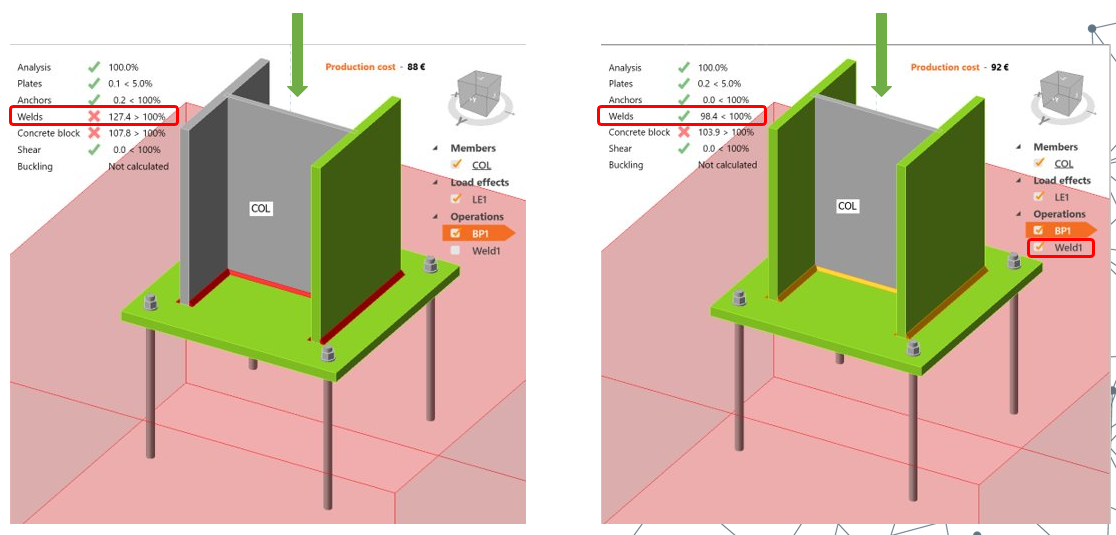Weld / Welds in IDEA StatiCa
Theoretical Background
Read the essential information about the weld model in our Theoretical Background. The general part describes the computational model itself:
Theoretical Background: Welded connections analysis
Specific parts of the Theoretical Background for each of the supported national standards:
- Code-check of welds (EN)
- Code-check of welds (AISC)
- Code-check of welds (CISC)
- Code-check of welds (AS)
- Code-check of welds (IS)
- Code-check of welds (HKG)
- Code-check of welds (GB)
- Code-check of welds (SP)
You can find a clear demo of how the stress develops during the loading as well as the distribution of the stress along the long welds is discussed in the How are welds modeled in IDEA StatiCa article.
Also, the welds and welded connections are discussed in our blog post articles Welded steel connections – to worry or not to worry? and Reduce weld costs by enhanced fabrication (where a combination of the load transfer through a weld and contact in compression is discussed).
Weld size and length
There are different ways how the size of the weld is defined, depending on the region. Read the Weld size and length article to find out, how IDEA StatiCa defines the weld size or in case you need to know the exact length of the weld:
Verifications
In our Support Center, you can find many verification studies describing the performance of different welded connection models as well as comparisons to laboratory tests.
Verification studies on models with welds
Updates in versions
The following features are part of our release notes of IDEA StatiCa and may be related to the welds. Read more about the features in the dedicated articles under the links:
Check of missing welds (version 20.1)
We have added another useful tool to automatically help the user to find non-welded parts of the connection: the utility to analyze a connection model for potentially missing welds.
Import of recommended welds (version 20.1)
When importing a connection from CAD software, there is now an option to add recommended welds.
Upgraded model of butt welds (version 20.1)
The size of butt welds was corrected for edge-to-surface butt welds.
Weld checks specifics as per Eurocode (EN) and Indian Standard (IS) (version 21.1)
To comply with the standards and to provide safety of the design, the strength value considered in the code check of welds is newly calculated from the strength value of the parent steel for EN and IS standards and the weld material itself.
Combining weld and contact operations (version 22.1)
Since version 22.1, the weld and contact operations can be combined.
Plate and weld clash check (version 22.1)
Plates, parts of the model can be positioned in a way that collides with the other plates and members.
Check welds of welded sections (version 23.0)
IDEA StatiCa can check the longitudinal welds of members with welded cross-sections now.
Improved weld check visualization (version 23.0)
Weld checking using a finite element method differs from traditional design calculations. In traditional calculations, small eccentricities, deformations, torsions, Poisson coefficient, etc. may be neglected.
Detailing improvements for bolts and welds in Eurocode (version 23.0)
The Detailing check in IDEA StatiCa Connection is improved. Engineers may have a better overview of the design and code-check of bolts and welds thanks to thorough information and recommendations according to Eurocode provided in Check tables as well as in the Report.
Webinars and videos
In the past, we have held several webinars on the modeling of welded connections. You can find inspiration in the following recordings:
Welds & Bolts in IDEA StatiCa (AISC)
The webinar session covers the theory behind bolts and welds and how they are modeled in IDEA StatiCa. Also, the operations of these two components will be detailed and some tips. Finally, the interpretation of the results will is explained and the formulas used to check that they meet AISC requirements.
Understanding the weld results for Eurocode
The detailed table with results can be seen in all formulas, even with values. Directional stresses are provided too. The utilization of the weld is eminent. But overall utilization Utc is calculated from the capacity of the whole weld. Check how it’s working.
Can we find a match in weld stress to my hand calculations?
The stress in a weld is calculated in the main directions according to the EC and the results are provided in the results tabs. Though the analysis in IDEA StatiCa Connection is based on CBFEM, in simple cases, the stress can be compared to hand calculations to verify the resulting values.
Setting fillet welds along with an SHS web and a plate surface
Hollow sections and mainly the curved corners of their cross-sections are sometimes tricky to deal with regarding welding etc. See how to properly set a simple fillet weld on both sides of an SHS member, along with its corners that have to be connected to a surface of a plate.














